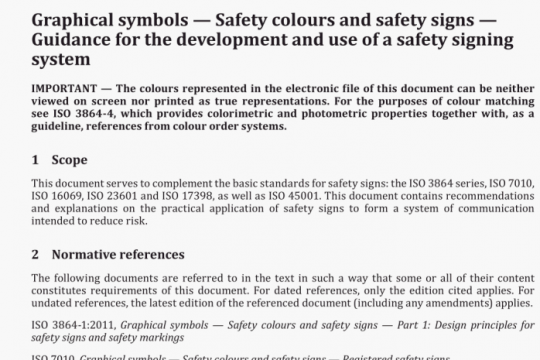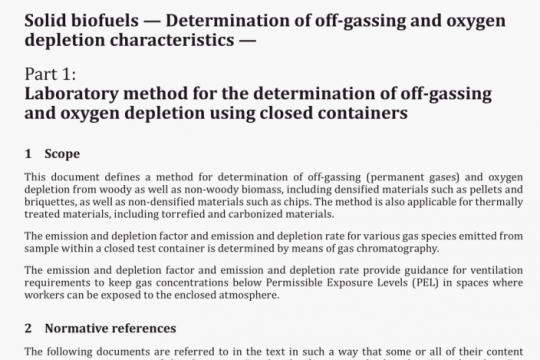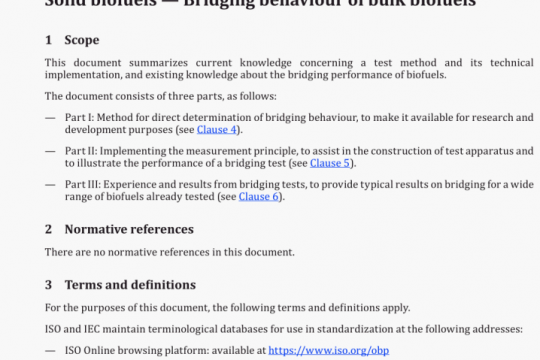PD ISO/TR 9901 pdf free download
PD ISO/TR 9901-2021 pdf free download.Solar energy一Pyranometers – Recommended practice for use.
Pyranometers classified in ISO 9060 as ‘spectrally flat have a spectral selectivity of less than 3 % (guard bands 2 %) in the 0,35 jim to 1.5 jim spectral range. This is the same requirement as in the previous ISO 9060:1990 for secondary standard pyranometers. Spectrally flat pyranometers are typically more accurate over a wide range of conditions, and applicable not only for horizontal measurement of global horizontal irradiance, GHI, but also for measurements of plane of array irradiance, POA, and reflected irradiance, RI, as well as for artificial solar sources such as lamps. IEC 61724-1 requires use of instruments of a specified accuracy class for its class A and B monitoring systems. There is consensus that the spectral selectivity specifications of ISO 9060 spectrally flat” pyranometers have a negligible (zero) spectral error and that they can be used for all the common outdoor measurements in solar energy studies with the same calibration (typically performed with the clear sky solar spectrum as the source) without significant loss of accuracy. The clear sky solar spectrum is one of the reference operating conditions for pyranometers if it is the source under which an instrument is calibrated or the source under which a calibration reference standard has been calibrated.
Pyranometers employing photodiodes (otherwise known as silicon-pyranometers), are not classified as “spectrally flat” in ISO 9060. The spectral error of pyranometers is defined for a set of clear sky solar spectra only. This implies that their spectral error for other than clear sky spectra cannot be based on the classification alone. The spectral error of pyranometers, in particular if they are not spectrally flat, may be larger for measurements of DHI, POA or RI than for clear sky GHI. The user may perform an individual uncertainty evaluation depending on the manufacturer specification of the instrument and the spectra of the measured radiation. The factory calibration of non spectrally flat instruments is typically valid for a set of clear sky solar spectra. Their sensitivity and uncertainty of their sensitivity may both change for different conditions.
Non spectrally flat pyranometers also may offer specific advantages; they generally are inexpensive, small and have a fast response time. They may be used for example for temporally highly resolved measurements, when overall accuracy requirements are not too high, or where constant spectrum conditions exist (for example, working with artificial sources, or only working under clear sky conditions). They also may be used for high-accuracy applications when calibrated under the working conditions.
In summary, spectrally flat pyranometers can be used for the most common solar testing applications, including GHI, POA, RI and albedo measurements using traceability to the same clear sky spectrum calibration. When using non-spectrally flat pyranometers for other than clear-sky GHI measurements, the spectral error may be larger than the spectral error specified in ISO 9060.
If a higher measurement accuracy is required than may be attained with a class A pyranometer, there also are class A pyranometers with improved directional error- and zero-offset specifications.
For the highest accurate measurement it is recommended to derive the hemispherical radiation from the combined measurements of a pyrheliometer and a shaded (i.e. shielded from direct radiation) pyranometer. These measure direct radiation and diffuse radiation respectively. There is international consensus that this type of measuring system provides the most accurate measurement possiblel •8 I.
Fast response pyranometers or spectrally flat fast response pyranometers are used when a fast response leads to a higher measurement accuracy. This may be to study highly variable sky conditions or over-irradiance events. ISiX9il&Q requires a 95 % response time <0,5 s to qualify for this sub-category.
4.3 Pyranometer and accessory selection based on other considerations
The accuracy classification of ISO 9060 does not by definition mean that a higher class pyranometer will provide a higher accuracy measurement; this entirely depends on the application. Users need to consider the suitability of a pyranometer not only based on the type or accuracy class, but also based on the detailed specifications of the pyranometer and its accessories.
As a first step, the requirements for the spectral response, see 42. and the operating conditions (temperature, irradiance, angle of incidence, tilt angle) may be established. The range of irradiance and ranges of operating conditions in indoor tests are usually smaller than those in outdoor tests, see £7 for indoor testing.
As a second step users could look at the accessories.
Reference is usually made to measuring and other specifications such as:
— specifications possibly exceeding those necessary for ISO 9060 classification, such as low zero offsets, good directional response, extended spectral range, faster response time, extended temperature range, as given by the manufacturer, or as established by testing;
— specifications of accessories such as external ventilations systems, shading mechanisms, etc.;
— additional measurements such as instrument temperature or internal humidity;
— type of output signal (digital vs analogue) or analogue output range;
— materials used; corrosive environments may require stainless steel;
— the price of instruments and accessories.
45 gives information about the most common accessories such as electronics and heating- and ventilation systems.
For studying events related to fast changes of irradiance, the response time may be the limiting factor. A fast response instrument, even if its classification may be lower, will then likely attain a higher measurement accuracy than a slower sensor. The sampling interval of the datalogger is typically chosen to be smaller than the instrument response time.
4.4 Measuring system redundancy and spatial resolution
To provide high-quality data, it is common practice to cross-check different radiation measurements or components and to have redundancy in each measurement. This also helps to reduce the risk of data loss and increase spatial resolution or coverage.
In many applications, duplicate measuring systems are installed; this is also practical for calibration; if one instrument is Sent away for calibration another still provides measurement data.
Redundant measurement stations also provide input for uncertainty evaluation. The difference between the measurement at one station and another provides information on spatial variability, in particular when the measured parameters include reflected irradiance, which is the case for POA or RI measurements.
A standard such as IEC 61724-1 contains a set of redundancy recommendations, specifying the number of POA and GHI measurements for different PV system sizes, expressed In megawatt power rating.
When measuring at large PV power plants, spatial resolution may play a role in design of the measuring system.PD ISO/TR 9901 pdf download.




